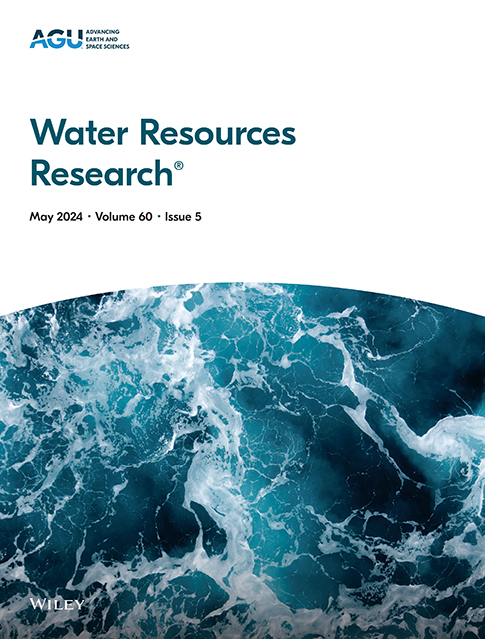明渠水流中水下柔性植被受到的阻力
IF 5
1区 地球科学
Q2 ENVIRONMENTAL SCIENCES
引用次数: 0
摘要
柔性沉水植被的移动会导致水流阻力增加。本研究利用稳定均匀明渠水流中植被的摇摆特性和流场信息,推导出了一种可直接计算高柔性沉水植被 Ceratophyllum 所受阻力的公式。水下柔性植被所受阻力的特征是时间平均流速、湍流强度和植被摇摆所产生的附加力。根据以往研究(Wang 等,2022a, 2022b, https://doi.org/10.1017/jfm.2022.598, https://doi.org/10.1017/jfm.2022.899)的数值模型结果,确定了阻力系数。结果表明,阻力系数受多种因素的影响,包括水流条件、植被的分布和运动特性。阻力系数随流速的增加而减小,与散流流速的三次方近似成线性关系。在植株间距为初始植株高度 0.5 倍的情况下,由于雷诺数从 20,000 到 50,000 不等,阻力系数从 10.72 到 2.11 不等。此外,植被分布密度和相对淹没度也会影响阻力系数。在这种情况下,阻力系数随着植株间距的增加而线性降低。当雷诺数等于 50,000 时,当植物间距为植物高度的 0.5 至 2 倍时,阻力系数为 2.11 至 2.02;当水流深度为植物高度的 1.5 至 3 倍时,阻力系数为 2.47 至 1.79。本文章由计算机程序翻译,如有差异,请以英文原文为准。
Drag Force on Submerged Flexible Vegetation in an Open-Channel Flow
The movement of submerged flexible vegetation leads to an increase in resistance to the stream flow. In this study, a formula that can directly calculate the drag force on a highly flexible submerged vegetation, called Ceratophyllum, by using the vegetation swaying characteristics and the flow field information in a steady-uniform open-channel flow is derived. The drag force on submerged flexible vegetation is characterized by the time-averaged flow velocity, turbulence intensity, and the additional force arising from the vegetation swaying. Based on the results of the numerical models in the previous studies (Wang et al., 2022a, 2022b, https://doi.org/10.1017/jfm.2022.598, https://doi.org/10.1017/jfm.2022.899), the drag coefficient is determined. It is revealed that the drag coefficient is influenced by a combination of factors, including the flow conditions, and the distribution and movement characteristics of vegetation. The drag coefficient decreases with an increase in velocity and is approximately linearly related to the cubic power of the bulk flow velocity. In the case of an inter-plant spacing of 0.5 times the initial plant height, the drag coefficient ranges from 10.72 to 2.11, as the Reynolds number varies from 20,000 to 50,000. Besides, the vegetation distribution density and the relative submergence influence the drag coefficient. In this context, the drag coefficient decreases linearly with an increase in the inter-plant spacing. For the Reynolds number equaling 50,000, the drag coefficient ranges from 2.11 to 2.02, when the inter-plant spacing varies from 0.5 to 2 times the plant height, and from 2.47 to 1.79, when the flow depth varies from 1.5 to 3 times the plant height.
求助全文
通过发布文献求助,成功后即可免费获取论文全文。
去求助
来源期刊

Water Resources Research
环境科学-湖沼学
CiteScore
8.80
自引率
13.00%
发文量
599
审稿时长
3.5 months
期刊介绍:
Water Resources Research (WRR) is an interdisciplinary journal that focuses on hydrology and water resources. It publishes original research in the natural and social sciences of water. It emphasizes the role of water in the Earth system, including physical, chemical, biological, and ecological processes in water resources research and management, including social, policy, and public health implications. It encompasses observational, experimental, theoretical, analytical, numerical, and data-driven approaches that advance the science of water and its management. Submissions are evaluated for their novelty, accuracy, significance, and broader implications of the findings.
 求助内容:
求助内容: 应助结果提醒方式:
应助结果提醒方式:


